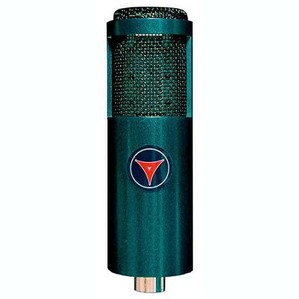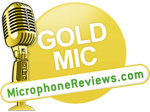Dual voice ribbon microphone

![]()
Dual voice means two different frequency curves, one on each side. So you basically get two mics in one. What’s more amazing is each side is its own respectable character for any number of applications. Responds beautifully with acoustic guitars, amps, vocals, or as a very warm drum and percussion room mic. It also comes with a unique mounting device.
![]()
Just use discretion when pulling up the signal in your pre because it can easily clip. That aside, there is nothing bad, at all, whatsoever.
![]()
Looking to get into ribbon microphones? Look no further. The Naked Eye will blow you away. No mic, to date, has captured acoustic and electric guitar in all their beauty and glory the way the Naked Eye has for me. And since it has dual voicing, you can double your parts with a quick spin of the mic, pan them out and get a great stereo image.
The Gemini of Ribbon Mics
Looking to get into ribbon microphones? Look no further. The Naked Eye will blow you away.
Crowley and Tripp is part of Soundwave Research Laboratories, Inc. They have a few divisions, spanning into the medical and scientific fields in addition to their microphones. It’s safe to say if that if you trust a company to make coronary catheters and ultrasound gear, you can trust them to make your microphones.
Once a company adopts a philosophical platform to make medical-grade equipment, the tendency is to uphold precision in its highest form. Soundwave Research seamlessly transferred that precision into the Naked Eye ribbon microphone.
Encased in a beautiful wooden box with the Crowley and Tripp emblem pyrographed on the front, the sleek and surprisingly small Naked Eye rests alongside a very unique mounting system. Let’s start there.
The mount is called a Monocle Mount, (Naked Eye…Monocle…get it?). The mount vaguely resembles the one-piece eyeglass from which it’s named. Basically, it’s a thin metal arm with a ring at the end that holds the mic by its base. It allows for easy positioning and minimizes vibrations.
In the words of Crowley and Tripp Product Manager Chris Regan, “By clearing away the space near the transducer, reflections are minimized, which is an issue with suspension mounts that incorporate lots of hair ties and strings and things that reverberate too close to the transducer.”
Onto the mic. Let’s put aside numbers and figures for a minute, and pretend we don’t know shit about hertz, polar patterns, decibels or any other crackpot measurements. This mic is a Gemini. It has two distinct personalities: the front (A) and the back (B). The “A” personality is a slightly darker, warm and calm tone that blends in well with the crowd. The “B” personality is a bright, playful texture that’ll cut through a crowded soundstage.
The tonal and textural differences are due to each side’s frequency curve. The major reason “B” is so bright is a consistent 5dB boost between 6kHz and 10kHz before rolling off the top end. The “A” starts to roll off about –6dB/octave around 5kHz.
Both sides are active any time the mic is plugged in. My initial thought was how to avoid bleed from one side to the other. Luckily, the Naked Eye is beyond a Gemini…it’s downright bipolar. The pickup pattern is a figure-8 (most all ribbon mics are), leaving the sides sharply divided. When you’re talking to one, the other doesn’t really hear you.
The Naked Eye was designed with guitars in mind, both acoustic recording and louder guitar cabinets. I positioned the “B” side in front of the acoustic’s 12th fret. Listening back, it sounded like our ears were actually in the body of the guitar. The presence was unmatched by any other mic I’ve ever used. It was a little boomy on the bottom end, so I eventually rolled that off to make room for the kick and bass, but it was so naturally beautiful that no other tonal adjustments were made.
When it came time to track the electric leads, I switched the mic around and put the “A” side to the guitar cabinet. The results were the creamiest tones I’ve ever drawn from that particular amp/guitar combo. For you guitar freaks out there, my guitarist uses an original Ibanez RG550 (customized) and a Fender Hot Rod Deluxe cabinet.
Looking back, it seems I grabbed more from the amp recording than I originally bargained for. The “A” side took the signal direct from the amp while the “B” side grabbed the sound bouncing back from the room, acting as a room microphone. I know I said earlier that when you talk into one side, the other doesn’t react, but in this case the cabinet was louder than an acoustic guitar or a human voice, so there was a bigger chance of slap back, and we didn’t use any cabinet isolation in a medium-to-live room.
Remember the “A” side is dark and warm and the “B” side is bright and ballsy. One would think recording acoustic would take the “A” side and recording electric leads would take the “B” side. That proved to be the exact opposite in my case. The “A” side on the acoustic clipped my Universal Audio pre; when I turned it down or compressed it, I lost so much volume that the signal wasn’t workable. Same for the “B” side on the cabinet. All its loudness was in its upper end, leaving out the body. My point is to experiment with the two sides on any given instrument and consider the result more than the means (always, not just with the Naked Eye).
The drums in this particular track called for a mix with more room sound. Although this situation would normally take my condensers, I decided to warm it up with the Naked Eye. Paired in a stereo configuration with another ribbon microphone, the “A” side delivered the perfect texture and response we were looking to achieve. Luckily the Naked Eye can handle very loud noises (up to 126dB @ 40kHz) without a whimper. So don’t be afraid to get it close to loud transients like your snare or timbales.
In yet another application, we used the Naked Eye to track a few vocals. We used the “B” side because we usually boost the top end for clarity. The tracks still used a little EQ for tweaking, but were generally left alone. After some gentle compression and a lot of Autotune, the vocals were shining through the mix.
So there it is: two ribbon mics in one. Normally you’d drop four digits on a single voice ribbon microphone. The Naked Eye is $829. It’s available at SoundwaveResearch.com.
Technical Info:
Mic Type: Ribbon
Operating Principle: electro-dynamic pressure gradient
Frequency Response: 20Hz – 16kHz (+-3dB)
Polar Pattern: figure-8
Sensitivity: -50dBV
Selectable Output Impedance: 75 Ohms (low), 300 Ohms (high)
Recommended Load Impedance: 300 – 600 (low), 1200 – 2400 (high)
High Pass Filter: Approx. 50Hz
Max. SPL: 138dB @ 0.5% THD
Generating Element: 2.5 micron corrugated aluminum ribbon
Price: $799
Be sure to check out the other Microphone Reviews
Were to Buy:

Speak Your Mind